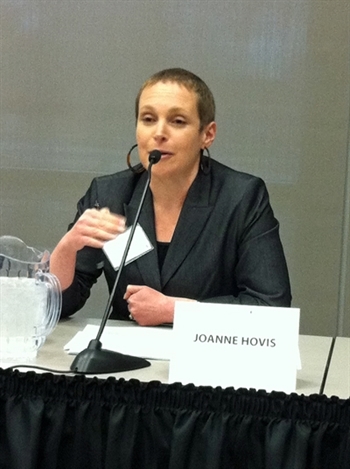 NAPERVILLE, Illinois, March 7, 2011 – A quartet of broadband award winners presented their most ambitious plans for improving Internet access and connectivity Monday, at a regional meeting hosted by Broadband Illinois. But once those presentations concluded, it fell to a trio of guests from Washington to weigh in on just how realistic and future-thinking those plans sounded.
NAPERVILLE, Illinois, March 7, 2011 – A quartet of broadband award winners presented their most ambitious plans for improving Internet access and connectivity Monday, at a regional meeting hosted by Broadband Illinois. But once those presentations concluded, it fell to a trio of guests from Washington to weigh in on just how realistic and future-thinking those plans sounded.
You could sense that many of the 100 attendees at Northern Illinois University’s Naperville campus were waiting with baited breath.
As it turns out, praise from inside the Beltway was unanimous, as all three D.C.-based experts gave high marks to the awardees, and Illinois in particular, for the ambition and scope of the plans that landed multi-million dollar grants.
“I was extraordinarily encouraged by what I heard today, particularly to hear how important evaluation was to all of the award winners—that it needs to be done at all levels of the project, not just at the 11th hour,” said Peter Arena of ASR Analytics, the program evaluation consultant to the National Telecommunications and Information Administration (NTIA). “And how do we do that? With numbers. The qualitative aspects are important, but people what to know: How many jobs did it create? How many anchor institutions were connected to the network? Very concrete things.”
Arena went so far to suggest that based on what he heard Monday, “Maybe Illinois is ahead of the curve on all that, and we'll soon find out. We'll be doing a very deep dive into that soon with case studies all over the country. But I was absolutely tickled by hearing how important evaluations were to everyone.”
Fellow panelist Joanne Hovis seemed confident Illinois could produce, stating that in her view, the state was “light years ahead” of other states in its broadband planning and execution, with only North Carolina as a peer.
“It’s a credit to you for the coordination and planning,” said Hovis, preident of the National Association of Telecommunications Officers and Advisors (NATOA). “But a lot of people will be watching to see what you accomplish. Hopefully it will point the ways to new business models as we try to bridge the broadband deficit, which unfortunately is formidable.”
Given the bitter legislative climate in D.C. these days, Hovis found the lack of politicking and partisan talk refreshing. “It always strikes me that when I come to events like this, the conversation we have outside Washington is so different to the one inside Washington. There broadband is a partisan issue. But as soon as I get outside of Washington, it has nothing to do with partisan politics, and that is such a pleasure.”
Echoing that sentiment, Randy Jenkins of the U.S. Department of Agriculture equated broadband today to electricity in the 1930s—a necessity of life that the public and private sector have to join forces to build out.
“Our agency started in 1935, when 20 percent of the people lived on 80 percent of the land mass, mostly with no connection to electricity,” said Jenkins, regional director of the USDA’s Broadband Initiatives Program [BIP]. “Today, there's a great need in rural America for fiber backhaul, for cell phone towers. The more fiber we can get closer to rural areas, the better.”
Jenkins said that the USDA has access to some $4.3 billion in federal funding, $3.5 billion of it in BIP funds. “We’ve been pushing the broadband issue since 1994 with our 550 telephone company clients.” Having been on the case so long, Jenkins liked what he heard Monday. “I worked with [awardee] Charles Wu [of Convergence Technologies] on his project, and we’ll try to make it succeed. And Connected Living [another awardee serving seniors] sounds like a rural community in one building. … Rural areas have too little population density, and too high costs.” Jenkins also encouraged anyone from the public or private sector who serves Illinois rural constituents with broadband issues to check out the USDA’s telecommunications page for RUS (rural utility service).
“There’s a loan component to the program,” Jenkins said. “The fact is that it’s not easy to build a last-mile component in an area of low density. If it were easy, it would be done by now. But the fact is, you’re making it easier, and I’m looking forward to having you fill in the last gaps.”
That said, it sounds like Illinois already has a head start—and a big one at that—in making the state a broadband showcase. “I’d credit Illinois’ elected and appointed officials,” Hovis said. “There’s a such a breadth of support and so many projects. It was breathtaking how many projects were funded by BTOP and BIP. … You have existing infrastructure, planning, advocacy and creativity that preceded the Recovery Act by many years.”
But all that funding and praise comes at a price: “You will be very closely watched,” Hovis repeated. She cited a recent study by the U.S. Small Business Association of rural and metropolitan areas. “The level of adoption is incredibly high for small businesses—92 percent. But when they talk about the applications they need, they don’t even understand that the speeds they need won’t even support those applications.”
Leaders in Illinois and its peer North Carolina seem to understand that, and have thus reaped the federal spoils so far. “Illinois and North Carolina are the two states we are blanketing for money,” Hovis said, “and we’ll be looking to you for real data and results to see what happens. Having watch broadband planning in Illinois, I’m really glad you have developed this institutional infrastructure… I wish all states were doing the same.”
Photo by Lou Carlozo